That man is doing something because he really wants to and knows that he can. A lot of us don't do things that we would really like to do because we are afraid it won't be perfect or just plain afraid of failure. I took up whittling and wood carving at 74 because at 25 I was afraid I would be no good at it. I'm not real good at it but it's good enough for me. We gotta do things to know our abilities. Excellent story line on this thread.
You are using an out of date browser. It may not display this or other websites correctly.
You should upgrade or use an alternative browser.
You should upgrade or use an alternative browser.
Building Blind
- Thread starter dave_person
- Start date

Help Support Muzzleloading Forum:
This site may earn a commission from merchant affiliate
links, including eBay, Amazon, and others.
- Joined
- Nov 26, 2005
- Messages
- 5,259
- Reaction score
- 11,089
Hi Folks,
It has been hard for Josh to get over to my shop because of his wife's schedule and it stormed on the last 2 dates we were able to set, preventing travel. Anyway, he made it today and we installed the barrel lugs. The barrel, barrel tang, ramrod groove and hole, and lock are now all inlet. Before starting shaping the stock, I wanted to get the barrel lugs installed. We are going to use captured barrel keys not pins. That will aid Josh taking out the barrel without risking losing small pins and figuring which pins go where. Josh used his Braille rulers to measure and mark where the lugs were to be installed. We discussed the issue of spacing and avoiding interfering with the ramrod thimbles. Josh worked out his solution and away we went. I had barrel lugs that I previously made but they needed the ends filed to 60 degrees. This is when we really tested our idea of finding the bodies "sweet spot" for filing straight or level. I showed him how to hold a lug in the vise and use a triangular file to set it at the proper angle to the vise to file a 60 degree dovetail. To do that he had to file level with the vice jaws and I watched as he set up to file and then had him shift one leg back (open his stance) which automatically set him up to file level. Remember, he cannot adjust his actions by sight so relies entirely on feel and body position. We proved the concept and I would urge everyone to think about it. When working for precision in shop work or shooting, don't fight your body. Make it work for you.
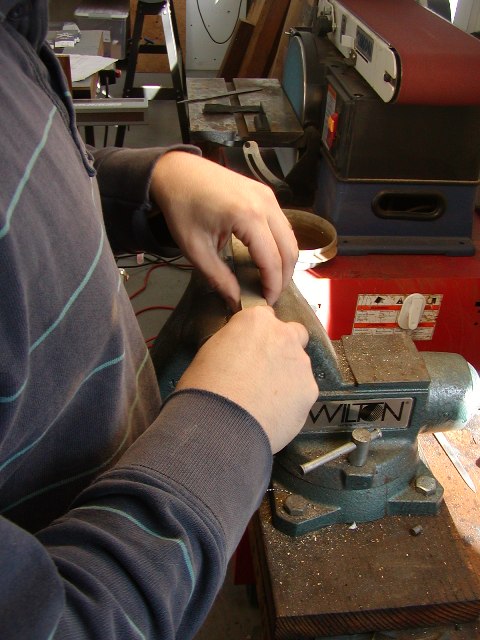
I cut the slots with a hacksaw but had Josh file the slots flat and the dovetails. He used the depth gauge on my calipers to make sure the slot was to the proper depth, however, I set the depth. I also cleaned up the slots and dovetails but only a little. After tapping in the lugs, he filed the excess metal on the bases flush with the barrel flats.
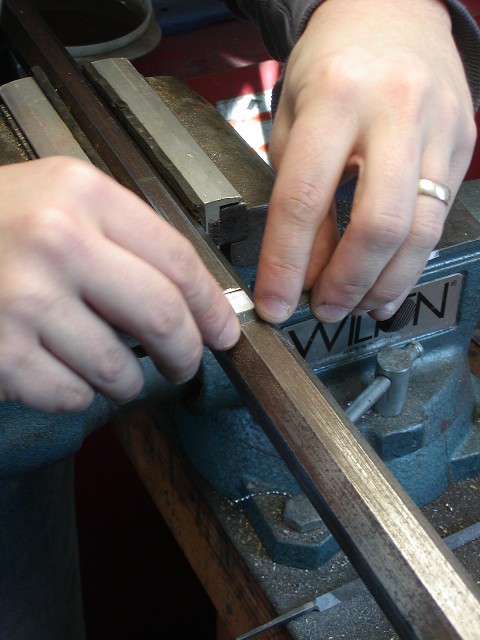
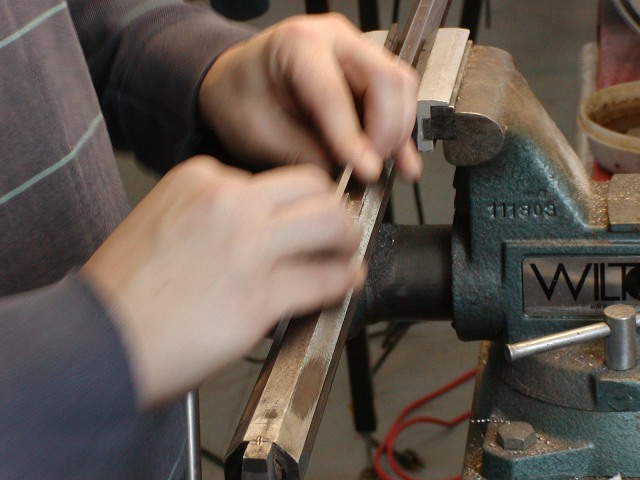
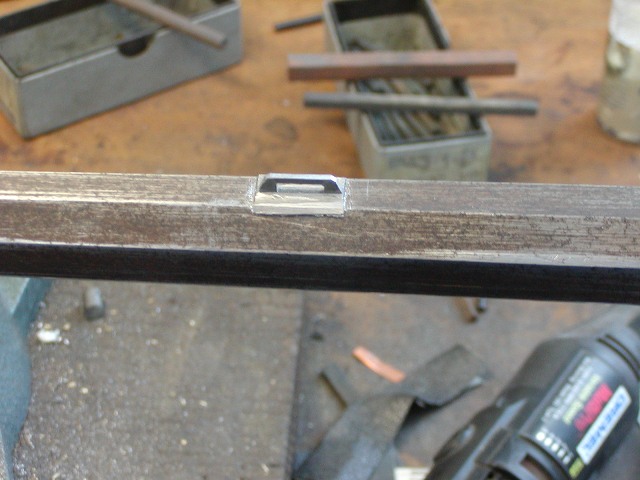
Next up was inletting the lugs in the stock. I had Josh use his Braille ruler to mark the lug base locations on the stock. Then I used inletting black to mark the locations of the actual lugs in the barrel channel. There is no way he can see those marks so I cut the slots in the wood for the lugs. However, he could measure the borders of the lug bases, which were raised a little above the barrel flats and had to be inlet. I helped him mark those borders with a chisel and he cut out the mortices. It worked out very well.
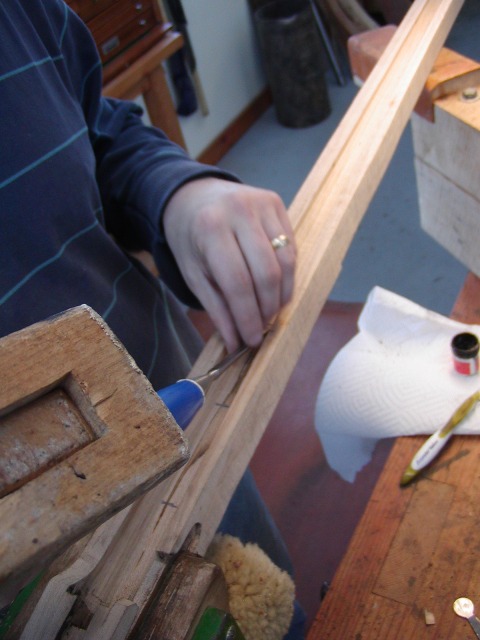
Before cutting the slots for the barrel key, I wanted to trim the sides of the stock. I cut off the excess wood and then showed Josh how to use my jack plane to even and square up the sides of the stock .
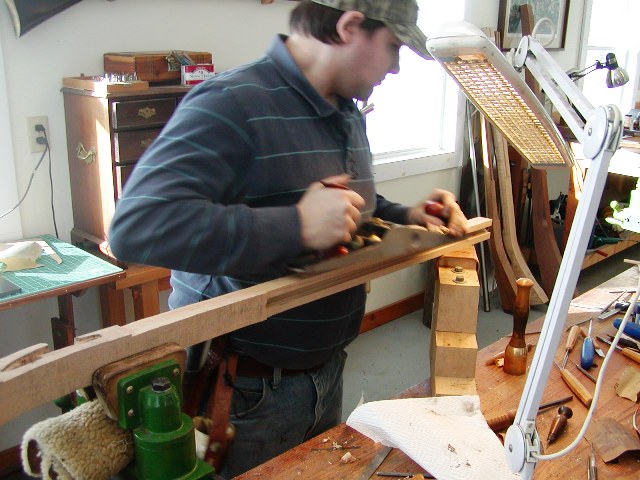
That is where we are and more to come but be patient.
dave
It has been hard for Josh to get over to my shop because of his wife's schedule and it stormed on the last 2 dates we were able to set, preventing travel. Anyway, he made it today and we installed the barrel lugs. The barrel, barrel tang, ramrod groove and hole, and lock are now all inlet. Before starting shaping the stock, I wanted to get the barrel lugs installed. We are going to use captured barrel keys not pins. That will aid Josh taking out the barrel without risking losing small pins and figuring which pins go where. Josh used his Braille rulers to measure and mark where the lugs were to be installed. We discussed the issue of spacing and avoiding interfering with the ramrod thimbles. Josh worked out his solution and away we went. I had barrel lugs that I previously made but they needed the ends filed to 60 degrees. This is when we really tested our idea of finding the bodies "sweet spot" for filing straight or level. I showed him how to hold a lug in the vise and use a triangular file to set it at the proper angle to the vise to file a 60 degree dovetail. To do that he had to file level with the vice jaws and I watched as he set up to file and then had him shift one leg back (open his stance) which automatically set him up to file level. Remember, he cannot adjust his actions by sight so relies entirely on feel and body position. We proved the concept and I would urge everyone to think about it. When working for precision in shop work or shooting, don't fight your body. Make it work for you.

I cut the slots with a hacksaw but had Josh file the slots flat and the dovetails. He used the depth gauge on my calipers to make sure the slot was to the proper depth, however, I set the depth. I also cleaned up the slots and dovetails but only a little. After tapping in the lugs, he filed the excess metal on the bases flush with the barrel flats.



Next up was inletting the lugs in the stock. I had Josh use his Braille ruler to mark the lug base locations on the stock. Then I used inletting black to mark the locations of the actual lugs in the barrel channel. There is no way he can see those marks so I cut the slots in the wood for the lugs. However, he could measure the borders of the lug bases, which were raised a little above the barrel flats and had to be inlet. I helped him mark those borders with a chisel and he cut out the mortices. It worked out very well.

Before cutting the slots for the barrel key, I wanted to trim the sides of the stock. I cut off the excess wood and then showed Josh how to use my jack plane to even and square up the sides of the stock .

That is where we are and more to come but be patient.
dave
Buckskinn
45 Cal.
Outstanding! Josh is doing an excellent job, looking forward to more updates!!!
SingleMalt
36 Cl.
Josh is doing a great job!
scooter3844
32 Cal
- Joined
- Jun 20, 2015
- Messages
- 48
- Reaction score
- 7
That is awesome. This young man is blind and building his own, yet I can see just fine and am scared to start one of my own. I applaud you and thank you for sharing.
I do what I can to take care of my Vermont family
Dave's "Vermont family" extends well beyond that states borders. As this Arkansan know. As generous as he is masterful in building rifles. Good on him and God bless both.
Overcoming an injury and/or a disability can be a huge mountain to climb. I know first hand about people saying no and doing a thing anyway. It's incredibly empowering. "If I can do this, what else can I do?" Keep going Josh, the finish line is in reality, just the starting line for the next great thing you do! We are in awe at the journey you've undertaken. The rest of us get to live vicariously through your vision!Hi Folks,
This project began with a phone call from Dave Keck. He said he spoke with a young man, Josh Tabor, from Vermont who was blind but was wanting to build a rifle and called him about a stock, barrel, and parts. Dave understood clearly that there were some issues involved and the caller was a bit confused about the building process and long rifles. He called me and asked if I could help Josh out because he was not sure he was able to do that very well. I do what I can to take care of my Vermont family so I contacted Josh. Josh was blinded and hearing impaired by disease when he was very young. He grew up in a farming family and has had a rough time because services for people with disabilities in rural America is pretty limited. He loves historical re-enacting but that community was lukewarm to him because of his blindness. He competed in primitive winter biathlons and woods walks in Vermont and harvested turkeys with a muzzleloader. He dreamed about building and owning a long rifle. I found Josh to be smart and able and decided to help him build a long rifle, which he will use in woods walks and hunts. Josh and I have no illusions about the gun building process. There are many steps that he cannot do but there are also many that he can, and I am committed to discovering just how much he can do. So we have started building a long rifle. He had an older Getz barrel, 54 cal, 38" long, swamped that was probably made for the early Haines kits. It was given to him by a friend. I had an older Siler lock that needed some upgrading, and bought parts to make it into a really first class lock. A local muzzleloading store owner had a good curly maple stock blank, which he sold for to Josh for a very small sum. The up shot is we are on our way. Dave Keck did an expert job inletting the barrel and drilling the ramrod hole. We designed a nice early Lancaster style gun and Josh is working with me to build it. Certainly, there are many tasks that I have to do but there are also many he can do and we are devising means for that to happen. Here are some early photos of Josh inletting the the bolster on the breech plug. One challenge was figuring out a way for him to hold the chisel perfectly vertical. He had a natural tendency to angle the chisel away from him. So we developed a rule that said place the chisel at the angle you think is vertical and then rock it back toward yourself a little. It worked. He got the bolster inlet quickly with minimal guidance. When he correctly flicked out the first chip of wood from the mortice, he smiled like a man really happy. With some guidance he inlet the barrel tang. There are a few little gaps but he did very well.
dave
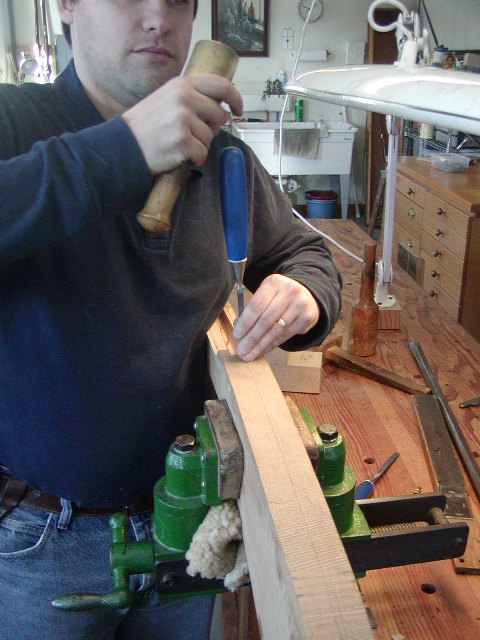
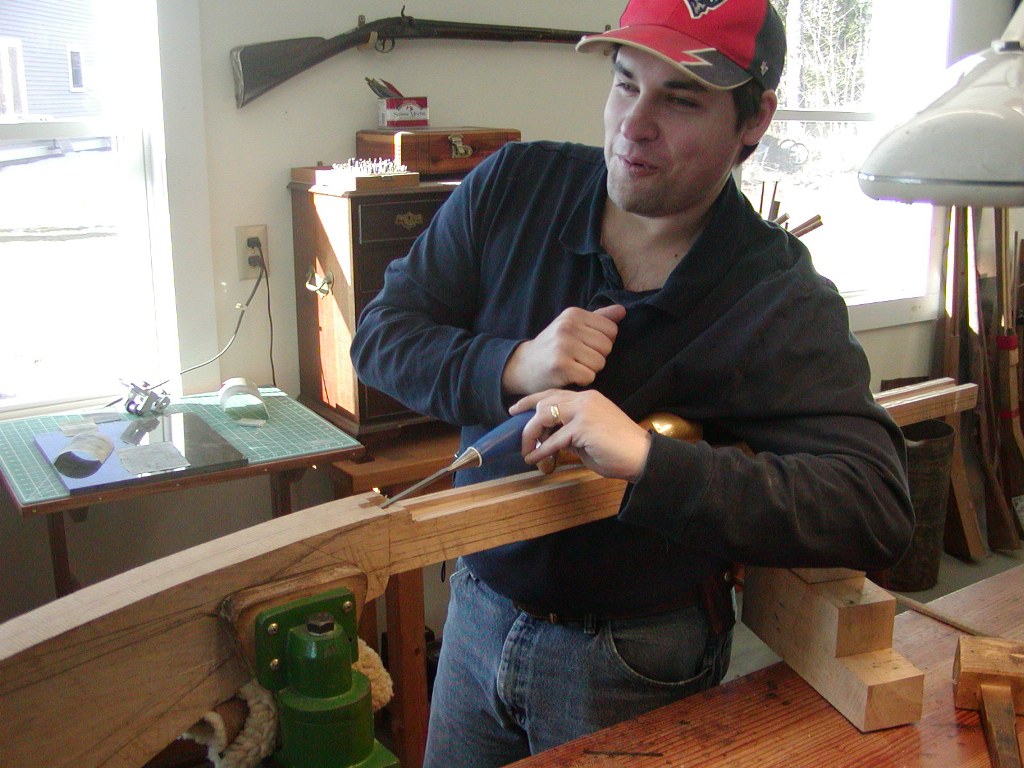
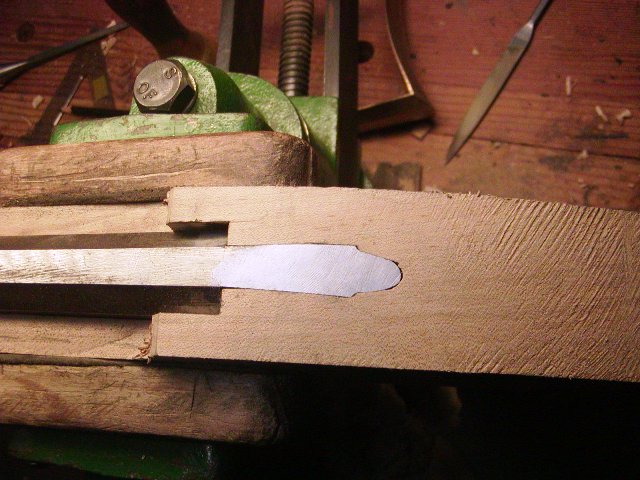
Neil
Cory Joe Stewart
32 Cal
So amazing.
- Joined
- Nov 26, 2005
- Messages
- 5,259
- Reaction score
- 11,089
Hi,
Josh was able to get over the mountains yesterday and we had a good long day of work on his rifle. We went from this:

to this:
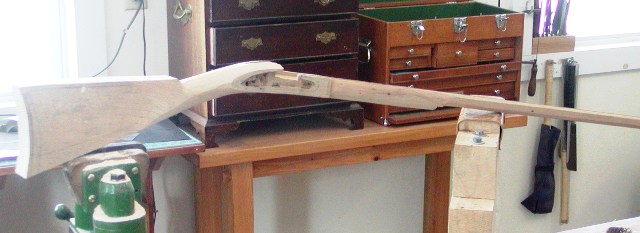
in one good hard working day.
I had Josh start off by planing facets on the fore stock as we pare it down evenly and shape it.
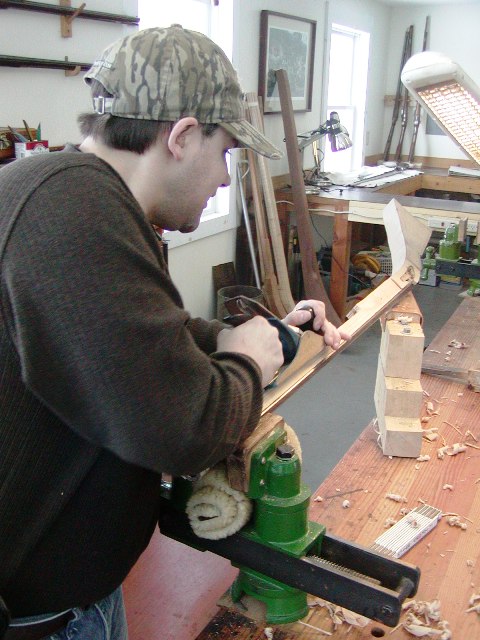
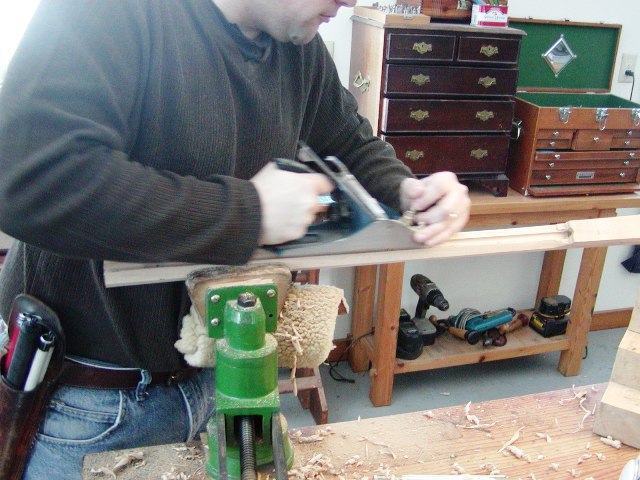
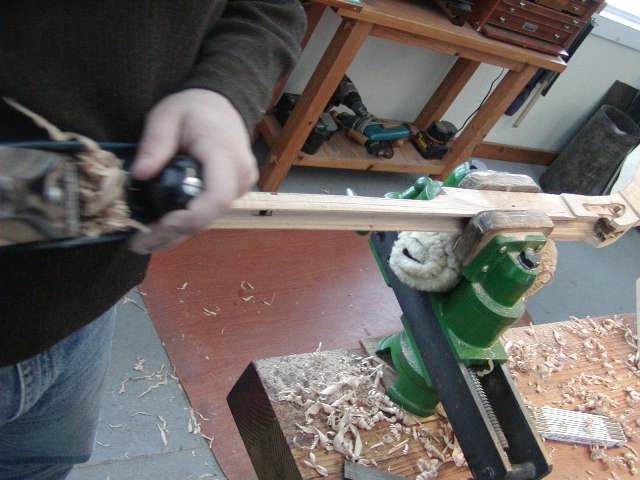
Then using my pattern maker's rasps, he filed facets where the plane could not reach.
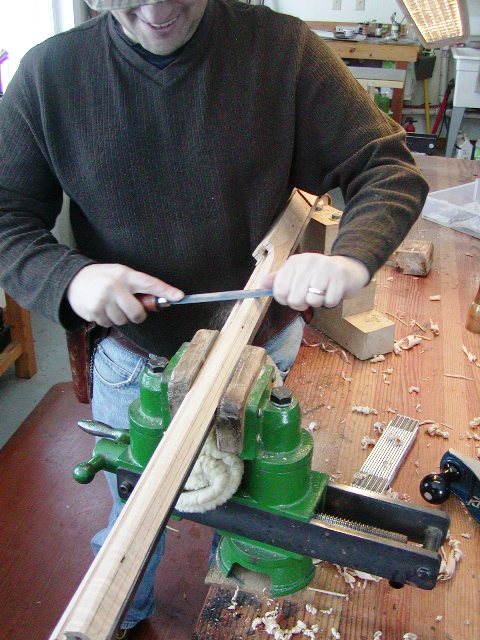
Next up was thinning and shaping the forearm using pattern maker's rasps.
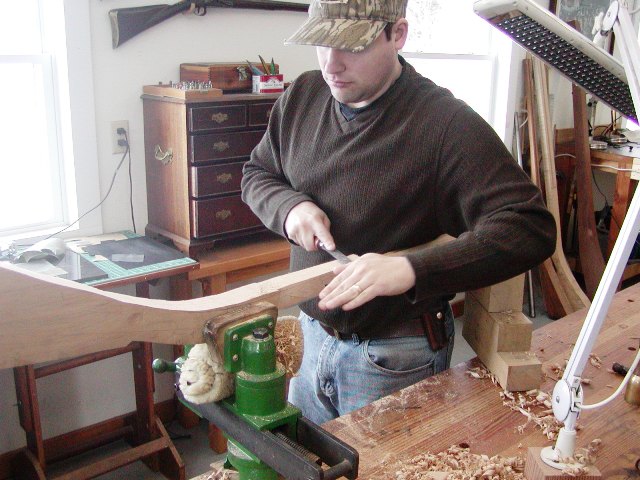
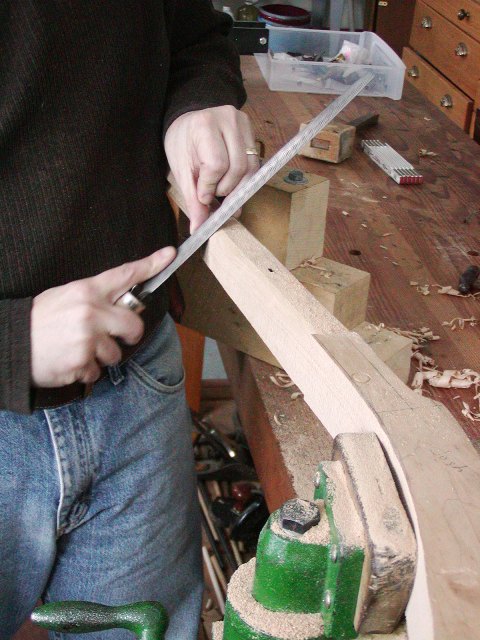
After that I had him start to shape the wrist after I trimmed off some excess wood with the band saw so were were right down to my outline on the wood. I taught him to do it the way I demonstrate at Dixons using pattern makers rasps.
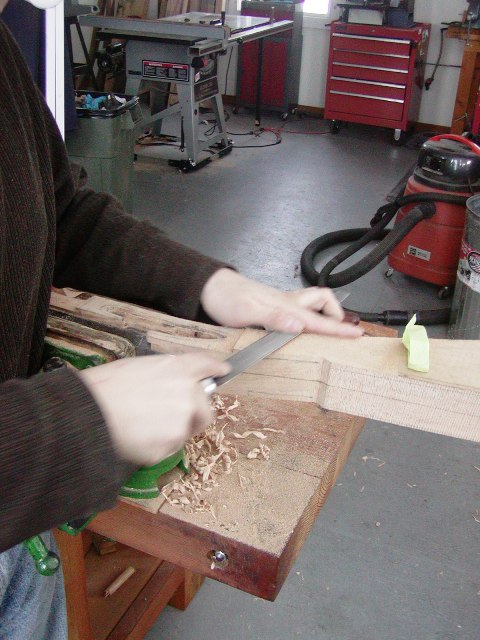
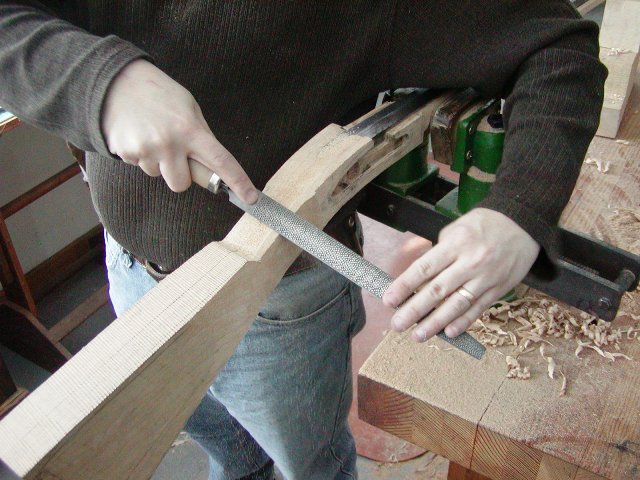
A happy gunsmith's apprentice

I do the drawing of all guidelines on the stock and usually start the task at a certain section, which then allows Josh to feel where the boundaries are for planing and filing for that task. Then I just let him have at it until the task is done. Sometimes I even up his work but lately, that is not necessary. He is figuring out how to do clean accurate work.
Well, here is where we are at the end of the day. I installed barrel keys for Josh and they came out really nice.
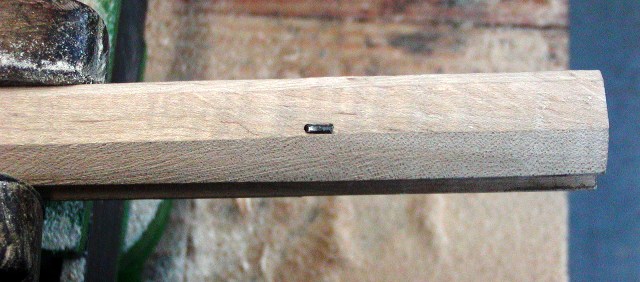
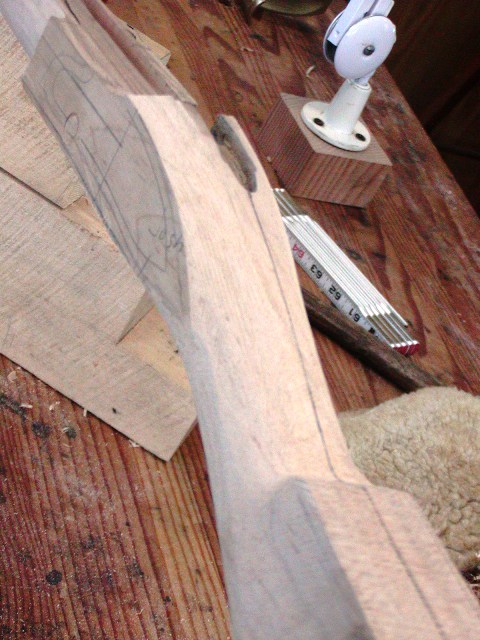
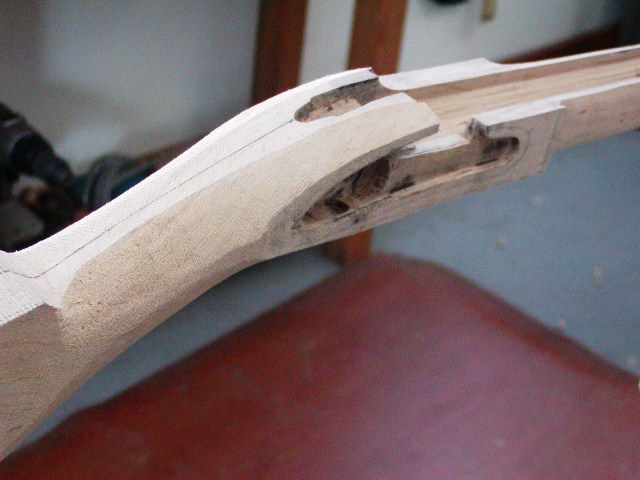
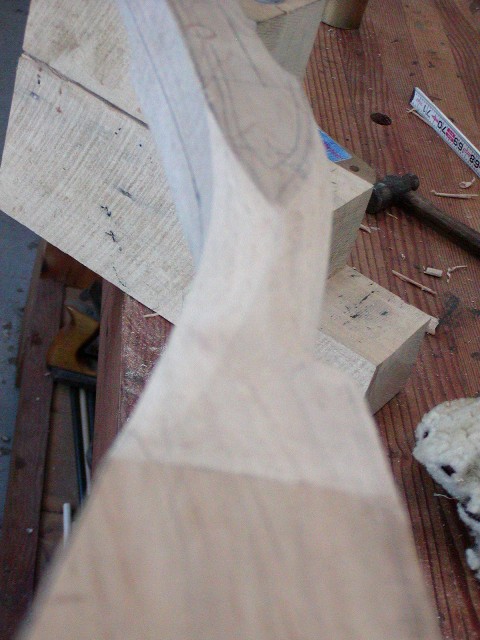
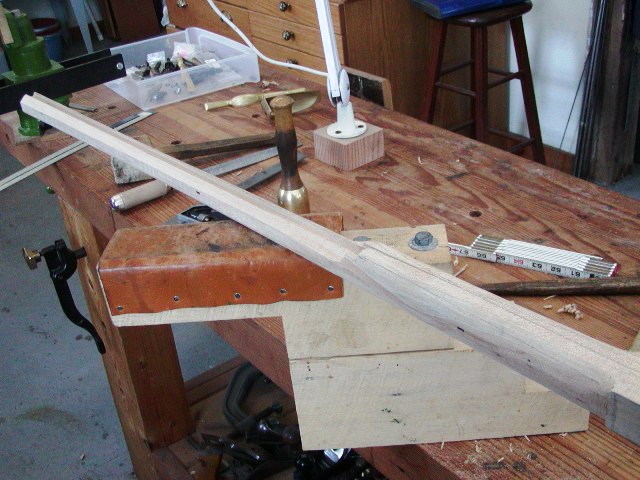
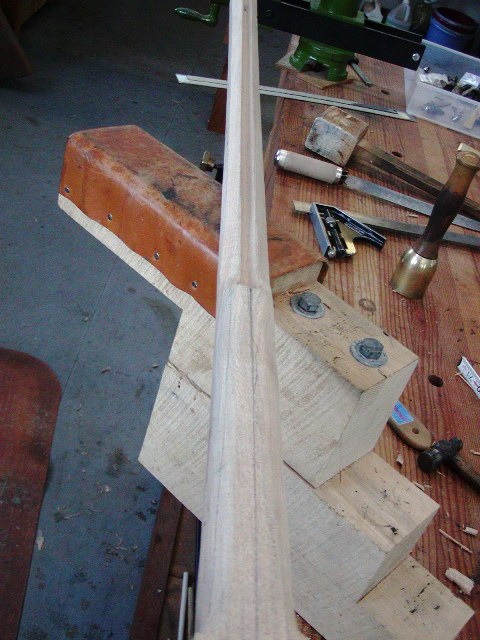
More wood comes off everywhere as we progress but it is starting to look like a rifle!
dave
Josh was able to get over the mountains yesterday and we had a good long day of work on his rifle. We went from this:

to this:

in one good hard working day.
I had Josh start off by planing facets on the fore stock as we pare it down evenly and shape it.



Then using my pattern maker's rasps, he filed facets where the plane could not reach.

Next up was thinning and shaping the forearm using pattern maker's rasps.


After that I had him start to shape the wrist after I trimmed off some excess wood with the band saw so were were right down to my outline on the wood. I taught him to do it the way I demonstrate at Dixons using pattern makers rasps.


A happy gunsmith's apprentice

I do the drawing of all guidelines on the stock and usually start the task at a certain section, which then allows Josh to feel where the boundaries are for planing and filing for that task. Then I just let him have at it until the task is done. Sometimes I even up his work but lately, that is not necessary. He is figuring out how to do clean accurate work.
Well, here is where we are at the end of the day. I installed barrel keys for Josh and they came out really nice.






More wood comes off everywhere as we progress but it is starting to look like a rifle!
dave
Last edited:
- Joined
- Aug 15, 2010
- Messages
- 5,382
- Reaction score
- 5,139
Dave, that is a wonderful thing you are doing helping this young man.
We should Never underestimate the human mind.
In college I sat next to the prettiest girl who was totally blind, and used a service dog. I learned so much about people who are visually impaired from her. I'll never forget the day she came in, sat down and asked to see my notes from the last class, she'd been absent...I thought she was joking, but she insisted. I handed her my notes and watched her run her fingertip across the ink on the page. I had never thought of being able to "feel" the ink on a page. But she could, and could read my left hand cursive writing, which is a chore for anyone. After she got used to my writing she was able to "scan" a page about as fast as i could write it.
I could go on, but this post is about the remarkable young man and his mentor. I could think of few who would be better for the task.
Bravo, Dave
We should Never underestimate the human mind.
In college I sat next to the prettiest girl who was totally blind, and used a service dog. I learned so much about people who are visually impaired from her. I'll never forget the day she came in, sat down and asked to see my notes from the last class, she'd been absent...I thought she was joking, but she insisted. I handed her my notes and watched her run her fingertip across the ink on the page. I had never thought of being able to "feel" the ink on a page. But she could, and could read my left hand cursive writing, which is a chore for anyone. After she got used to my writing she was able to "scan" a page about as fast as i could write it.
I could go on, but this post is about the remarkable young man and his mentor. I could think of few who would be better for the task.
Bravo, Dave
- Joined
- Nov 26, 2005
- Messages
- 5,259
- Reaction score
- 11,089
Hi,
Finally back at it! Josh and I felt it was safe to get going again in my shop. His wife works in health care and is tested frequently and virus cases where Josh lives are very few with no new cases in over a month. Same where I am so we figured it was OK to get some work done on his rifle. I installed his butt plate and inlet his trigger so we could test the fit and adjust things if needed. So far it seems to fit him well. Next up was inletting the ramrod pipes. He had some cast ones so we used those to speed things up rather than make them from sheet. The photos shows a pipe on which I filed a notch in the tab. the notch or notches indicate to him which pipe he is handling and the direction toward the muzzle it should be inserted. I determined their locations on the stock.
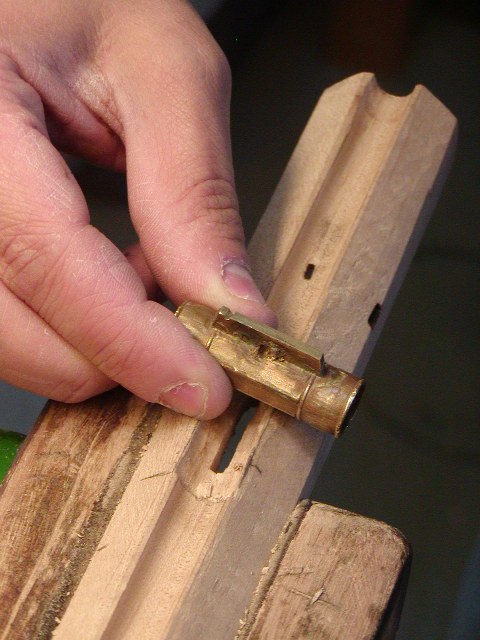
Then I marked holes in the stock for the tab and he drilled them out. Next, he cleaned the slots with a little saw and thin flat file. Next, I cut the outlines and Josh cut the mortices with a gouge. Note how he has to hold the gouge a little oddly so his pinky or ring finger feels forward of the tool so he can tell where to stop the cut. I also gave him a lighter wooden mallet with a big rectangular head which helps him tap the chisel but also keeps the blows light.
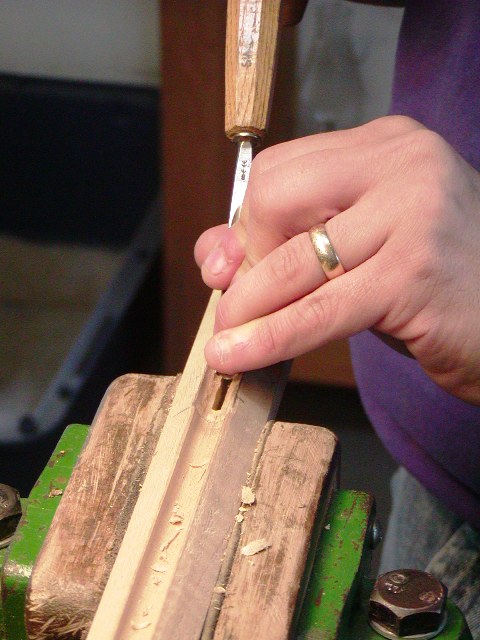
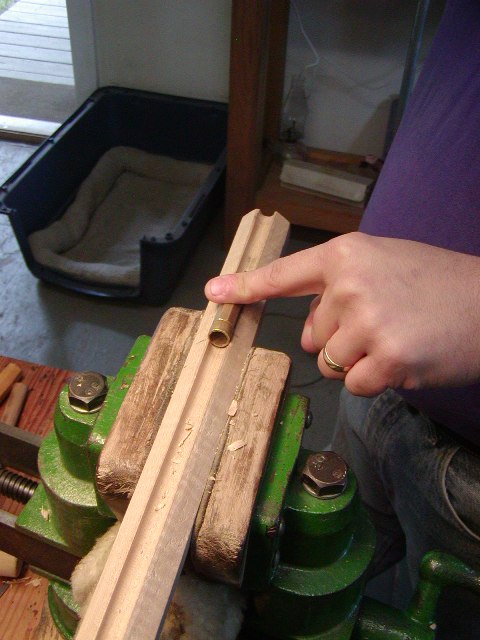
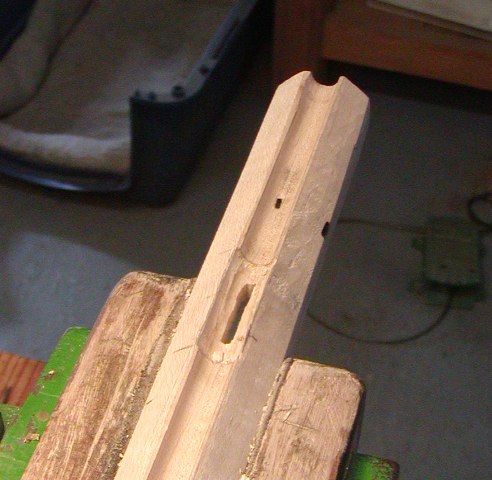
He did a fine job. When the depth was cut, I took over and using inletting black, checked the fit. The pipes came out very well.

Josh gets nervous when I put black on parts because when he asked me if I would tell him if he accidentally smeared black on his face, I told him "no" . Then he asked if I really wanted him to go out in public with inletting black smeared on his face and I said "yup". I have to be careful because he is a skilled martial artist. Because the pipe portion of the rear pipe is identical to the other pipes, I had Josh inlet one of the other pipes at the position of the rear pipe. Then it was just a matter of me inletting the tang. It worked pretty well. I did it that way because the job really requires inletting black most of the way through to remove pinch points.
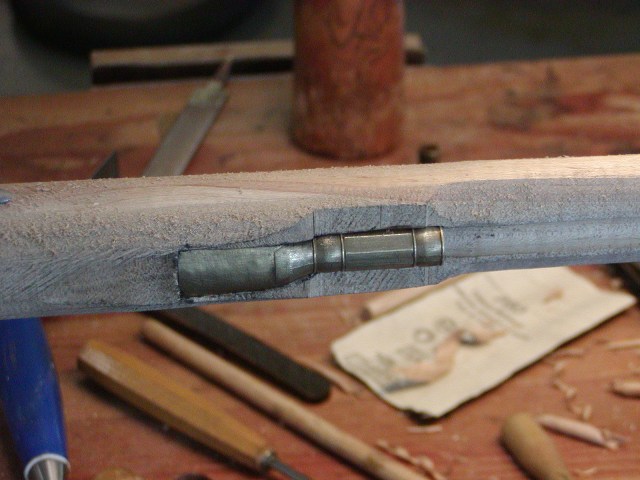
Finally, I had Josh remove more wood from the fore stock. To help him keep things even, I have him rasp flats using long strokes. I position the stock in my vise so he can file a flat while holding his rasp horizontally. He's learned how to do that and adjust for his body's tendency to tilt the rasp from horizontal. So he places the rasp on the stock, holds it where he thinks it is level and then rocks it toward him a tiny bit, which achieves true horizontal orientation. We increase the number of flats and the stock eventually becomes evenly rounded.
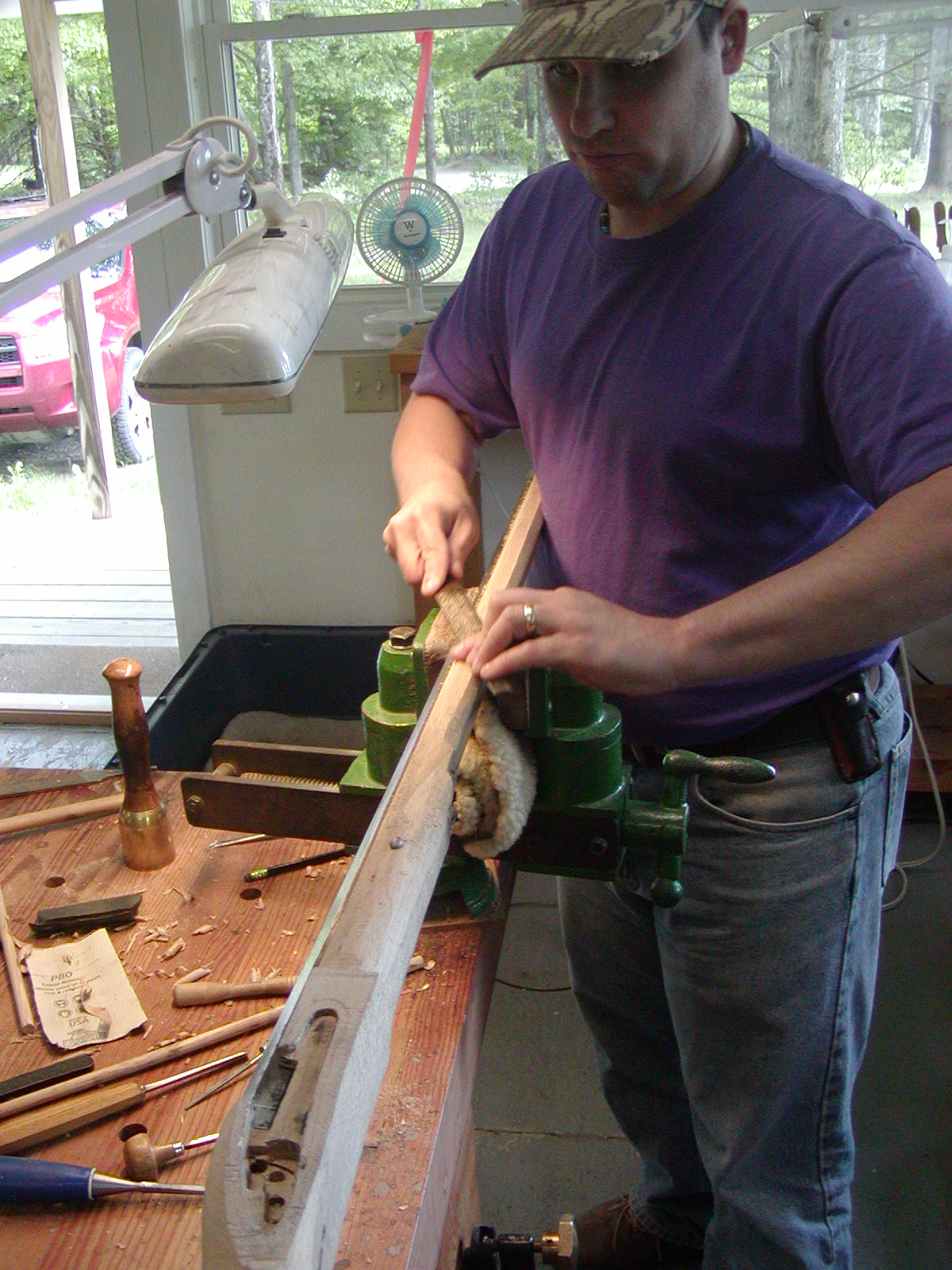
Next time, we shape the butt and cut the cheek piece.
dave
Finally back at it! Josh and I felt it was safe to get going again in my shop. His wife works in health care and is tested frequently and virus cases where Josh lives are very few with no new cases in over a month. Same where I am so we figured it was OK to get some work done on his rifle. I installed his butt plate and inlet his trigger so we could test the fit and adjust things if needed. So far it seems to fit him well. Next up was inletting the ramrod pipes. He had some cast ones so we used those to speed things up rather than make them from sheet. The photos shows a pipe on which I filed a notch in the tab. the notch or notches indicate to him which pipe he is handling and the direction toward the muzzle it should be inserted. I determined their locations on the stock.

Then I marked holes in the stock for the tab and he drilled them out. Next, he cleaned the slots with a little saw and thin flat file. Next, I cut the outlines and Josh cut the mortices with a gouge. Note how he has to hold the gouge a little oddly so his pinky or ring finger feels forward of the tool so he can tell where to stop the cut. I also gave him a lighter wooden mallet with a big rectangular head which helps him tap the chisel but also keeps the blows light.



He did a fine job. When the depth was cut, I took over and using inletting black, checked the fit. The pipes came out very well.

Josh gets nervous when I put black on parts because when he asked me if I would tell him if he accidentally smeared black on his face, I told him "no" . Then he asked if I really wanted him to go out in public with inletting black smeared on his face and I said "yup". I have to be careful because he is a skilled martial artist. Because the pipe portion of the rear pipe is identical to the other pipes, I had Josh inlet one of the other pipes at the position of the rear pipe. Then it was just a matter of me inletting the tang. It worked pretty well. I did it that way because the job really requires inletting black most of the way through to remove pinch points.

Finally, I had Josh remove more wood from the fore stock. To help him keep things even, I have him rasp flats using long strokes. I position the stock in my vise so he can file a flat while holding his rasp horizontally. He's learned how to do that and adjust for his body's tendency to tilt the rasp from horizontal. So he places the rasp on the stock, holds it where he thinks it is level and then rocks it toward him a tiny bit, which achieves true horizontal orientation. We increase the number of flats and the stock eventually becomes evenly rounded.

Next time, we shape the butt and cut the cheek piece.
dave
Cruzatte
50 Cal.
The rasping technique of filing flats then to round on the forestock is the same idea I came up with in shaping my FDC. Great work. I'm enjoying this thread very much.
- Joined
- Dec 25, 2019
- Messages
- 72
- Reaction score
- 9
Dave, I agree withKansas Jake. This is a great thread to learn many things from. I think you and Josh are both fortunate, as we are to be able to witness this from afar. I look forward to more pictures as well as the final of two smiles and a beautiful rifle. Thanks, dc
- Joined
- Nov 26, 2005
- Messages
- 5,259
- Reaction score
- 11,089
Hi,
Josh and I thank everyone for looking and commenting. I keep him informed of your support. He really is flattered and grateful. I do believe this thread does teach all of us some basic procedures. In a sense, we all have similar issues with our skills but for Josh, the hurdles are magnified. Anyway, I am learning that things I do without really thinking can be broken down into components as I do with Josh, and that partitioning really identifies key pieces of the skills I execute. That gives me teaching tools that can benefit everyone.
dave
Josh and I thank everyone for looking and commenting. I keep him informed of your support. He really is flattered and grateful. I do believe this thread does teach all of us some basic procedures. In a sense, we all have similar issues with our skills but for Josh, the hurdles are magnified. Anyway, I am learning that things I do without really thinking can be broken down into components as I do with Josh, and that partitioning really identifies key pieces of the skills I execute. That gives me teaching tools that can benefit everyone.
dave
Thunder14
32 Cal.
Both Josh and Dave are amazing men.
- Joined
- Nov 26, 2005
- Messages
- 5,259
- Reaction score
- 11,089
Hi Folks,
Thanks for the comments and I passed the support on to Josh. He appreciates the encouragement very much. We got quite a bit more done. Josh is able to get over here every Saturday or Sunday so we can make steady progress. It is slow though because it takes him more time to get tasks done but that really doesn't matter. I had him clean up the pipes with fine files and they are ready for final polish later.

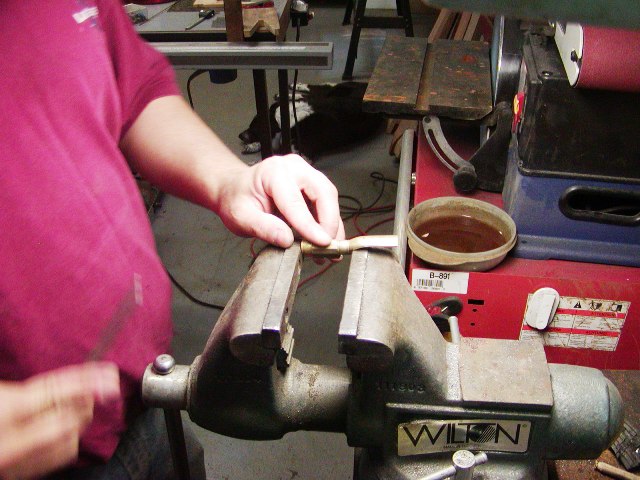
He did a lot more shaping of the stock using a pattern maker's rasp and coarse file and we roughed out the cheek piece.
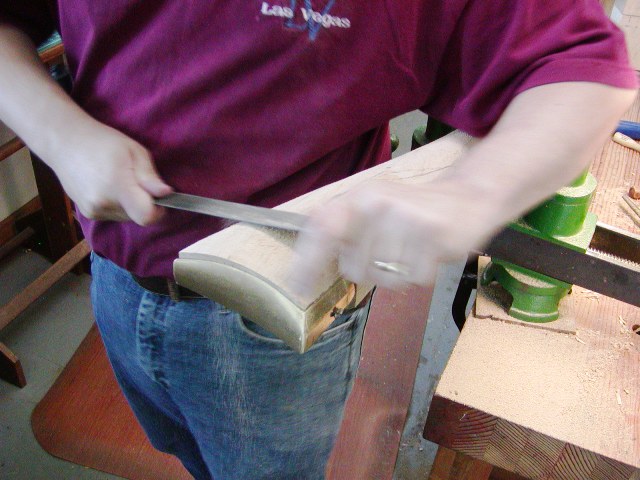
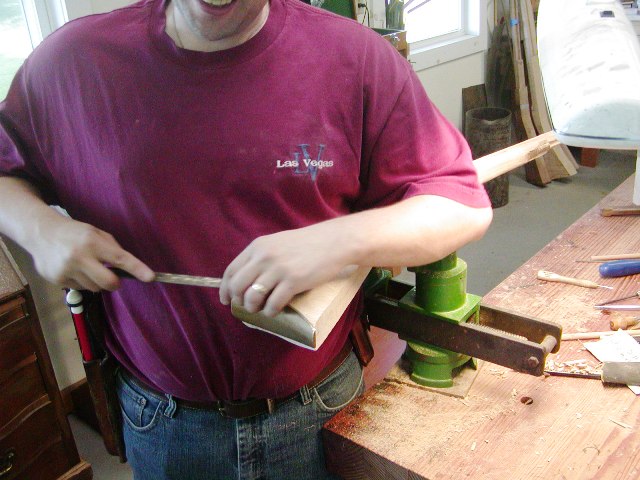
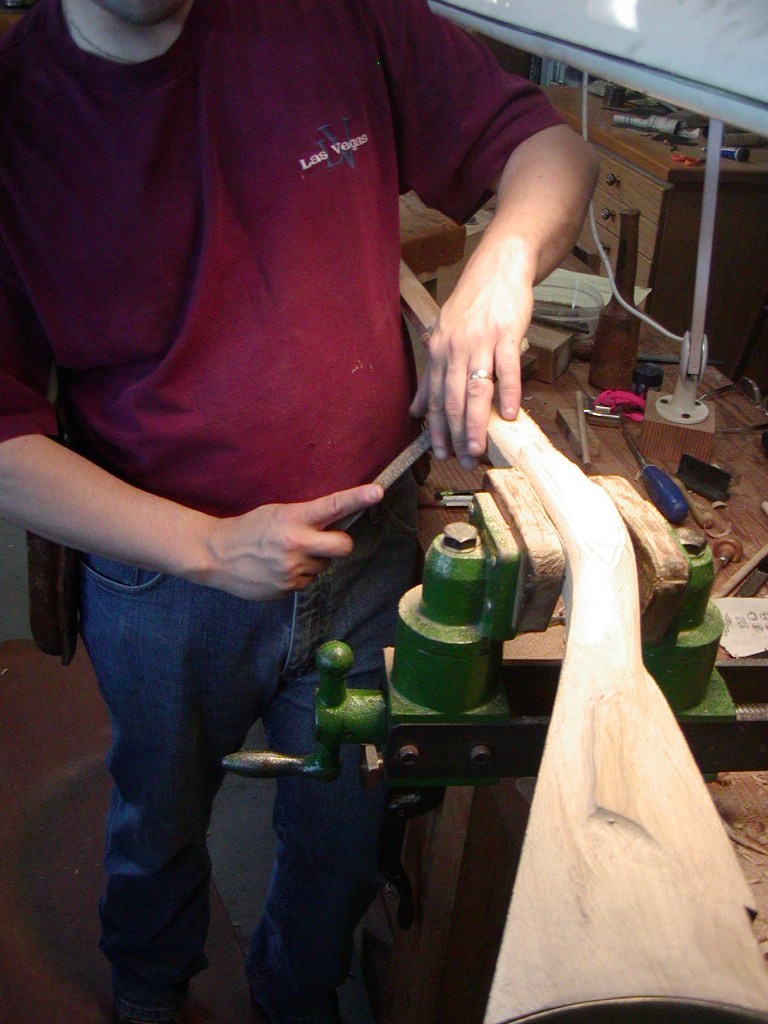
Next we made a trigger plate from steel and I had Josh file the trigger slot and clean up the edges of the plate. Then I drilled the tang bolt and used the hole to position the trigger plate. I had Josh inlet it. He did the complete inlet by himself. He did a good job but you can see a few gaps and one place near the tail where he cut outside the outline of the plate. No problem, a wood chip and super glue to the rescue.
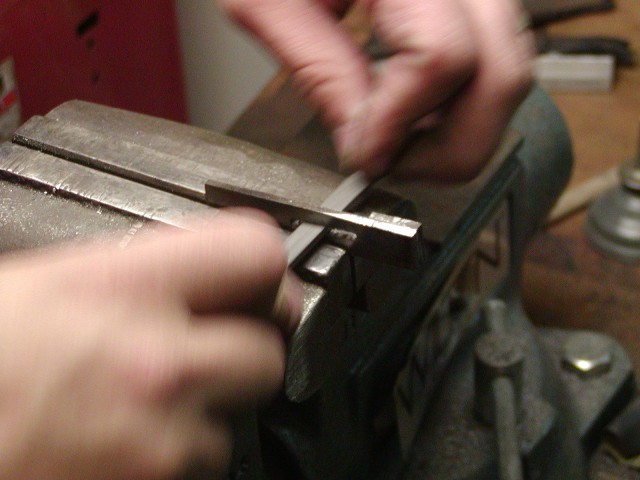

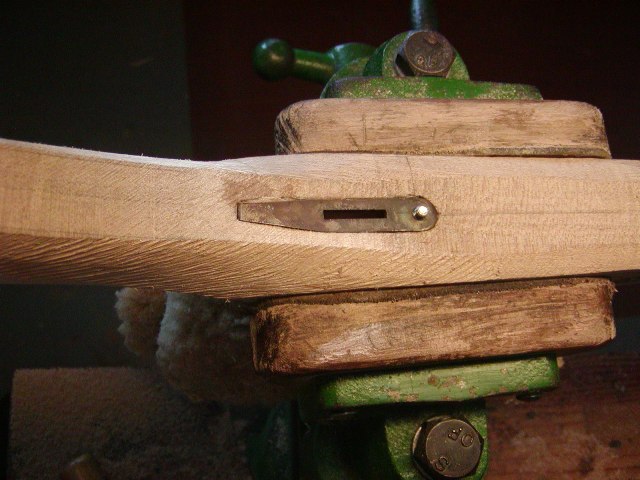
After inletting the trigger plate and positioning the trigger, I had Josh bring the forestock down to almost finished dimension. I have him use a method of planing, rasping, and filing flat faces like the flats on an octagon barrel. He then increases the number of flats on each side until the cross section of the stock is round and even. It seems to work well for him. After paring down the fore stock, it was time to make and install a muzzle cap. I shape the wood where the cap will go first and then use it as a form for bending the brass sheet to make the cap. To begin, I marked where the rear edge of the cap will meet the wood with masking tape. Then I had Josh use a very fine Japanese saw to shallowly cut along the edge of the tape. These saws have no kerf and cut on the pull stroke creating very clean and precise cuts. I rarely ever have to go back and clean up the edge of the wood for a perfect fit to the cap. After sawing the edge, I had Josh back cut the line with a chisel to create a trench he could feel. Then he used a coarse file to take down wood from around the muzzle stopping at the back cut. He used the method of little flats to create an evenly rounded surface. Using a chisel, he cleaned up the back edge.

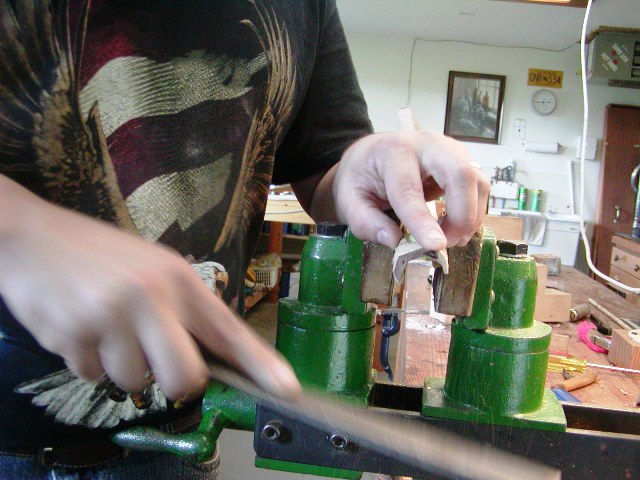
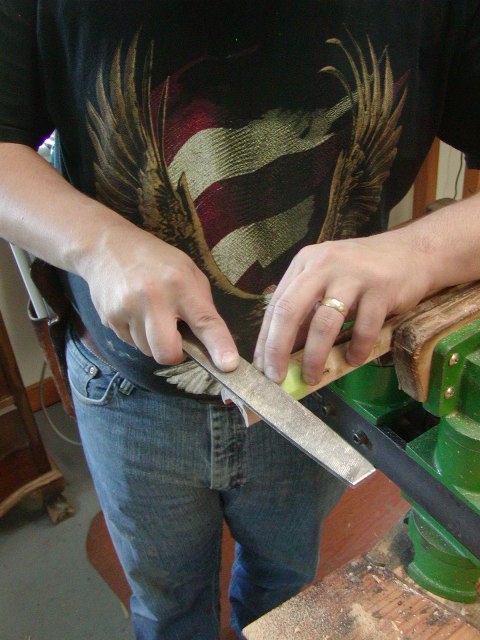
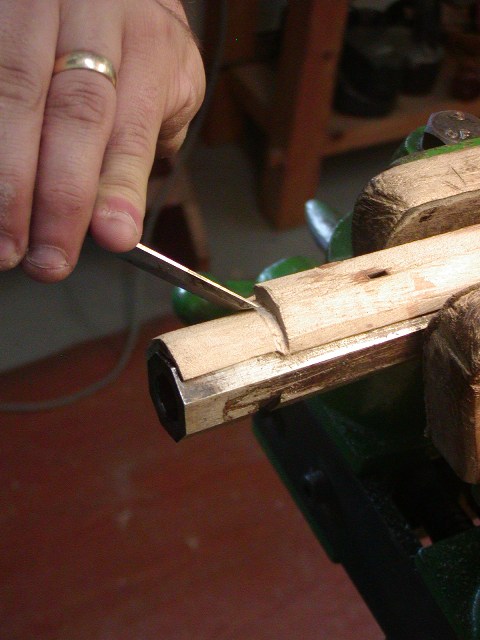
I cut and annealed some sheet brass, which he bent around the muzzle using the shaped wood as a form. We finished the bending process by attaching 2 hose clamps and tightening them down. The result was perfect.

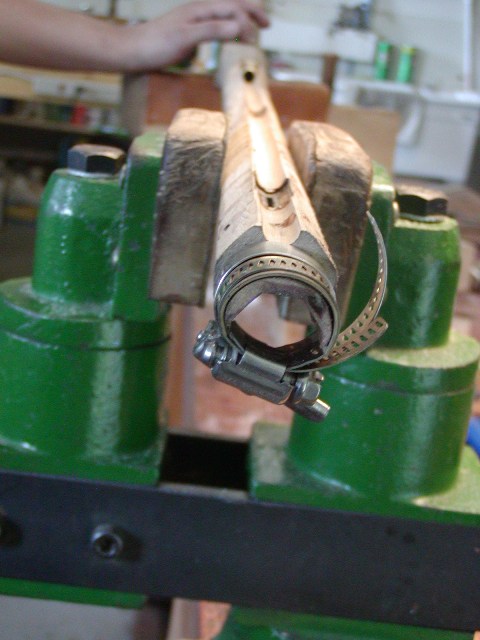
After bending the sheet. I had Josh trace the inside profile of the cap on a thicker piece of brass that will form the front. I cut and filed the front to that scribed profile and soldered it inside the front of the cap. To speed things up a bit, I cut and filed the profile of the barrel muzzle into the front of the cap and Josh and I final fitted it to the stock.
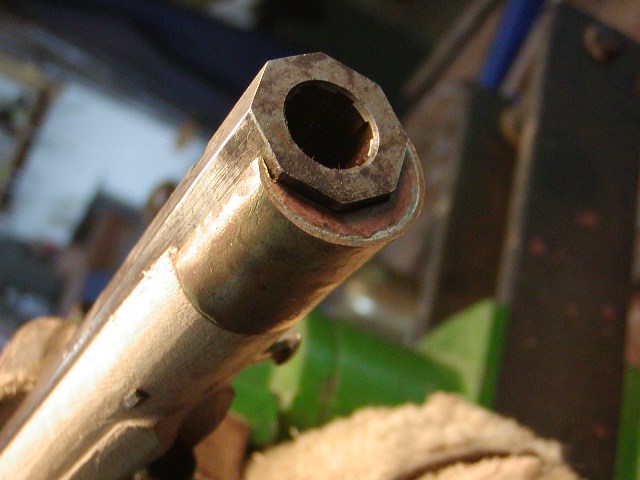
Finally, he pared more wood down on the fore stock so it was near flush with the muzzle cap and we cut the ramrod channel moldings. I marked lines on the stock and using an old marking gauge, scribed a line in the wood. I use a coarse checkering tool to deepen that line and then a dog leg chisel to relieve back ground wood along that line creating a raised shoulder. It takes about 20 minutes per side to do. Since Josh could now feel and use that shoulder as a guide or fence, I had him clean up the background with the dog leg chisel, bottoming file, and straight Japanese rasp with safed edges. He did a good job. There are a few spots I will clean up but it will look crisp and straight when we are finished.

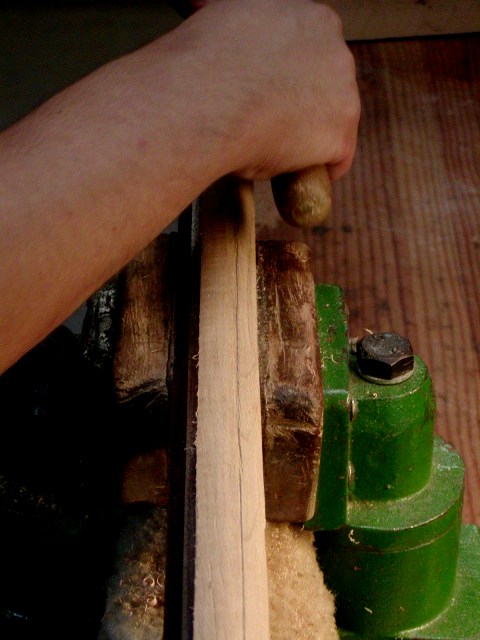
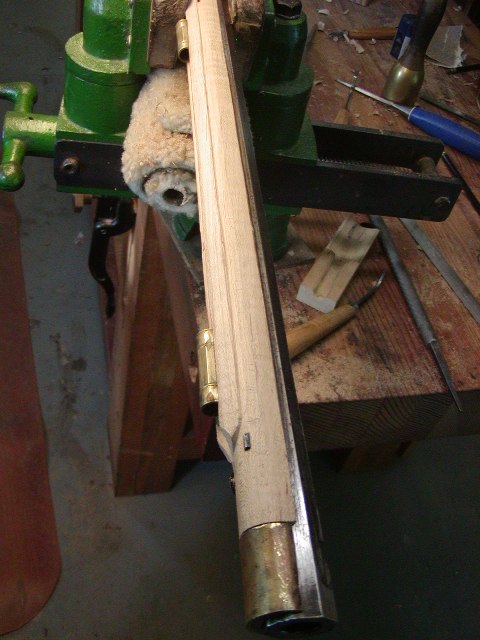
Well that was it for a couple long days of work. We worked pretty late yesterday and when the sun was brewing up a nice sunset

we figured it was time to drive Josh back to where he meets his wife to go home in Rutland.
dave
Thanks for the comments and I passed the support on to Josh. He appreciates the encouragement very much. We got quite a bit more done. Josh is able to get over here every Saturday or Sunday so we can make steady progress. It is slow though because it takes him more time to get tasks done but that really doesn't matter. I had him clean up the pipes with fine files and they are ready for final polish later.


He did a lot more shaping of the stock using a pattern maker's rasp and coarse file and we roughed out the cheek piece.



Next we made a trigger plate from steel and I had Josh file the trigger slot and clean up the edges of the plate. Then I drilled the tang bolt and used the hole to position the trigger plate. I had Josh inlet it. He did the complete inlet by himself. He did a good job but you can see a few gaps and one place near the tail where he cut outside the outline of the plate. No problem, a wood chip and super glue to the rescue.



After inletting the trigger plate and positioning the trigger, I had Josh bring the forestock down to almost finished dimension. I have him use a method of planing, rasping, and filing flat faces like the flats on an octagon barrel. He then increases the number of flats on each side until the cross section of the stock is round and even. It seems to work well for him. After paring down the fore stock, it was time to make and install a muzzle cap. I shape the wood where the cap will go first and then use it as a form for bending the brass sheet to make the cap. To begin, I marked where the rear edge of the cap will meet the wood with masking tape. Then I had Josh use a very fine Japanese saw to shallowly cut along the edge of the tape. These saws have no kerf and cut on the pull stroke creating very clean and precise cuts. I rarely ever have to go back and clean up the edge of the wood for a perfect fit to the cap. After sawing the edge, I had Josh back cut the line with a chisel to create a trench he could feel. Then he used a coarse file to take down wood from around the muzzle stopping at the back cut. He used the method of little flats to create an evenly rounded surface. Using a chisel, he cleaned up the back edge.




I cut and annealed some sheet brass, which he bent around the muzzle using the shaped wood as a form. We finished the bending process by attaching 2 hose clamps and tightening them down. The result was perfect.


After bending the sheet. I had Josh trace the inside profile of the cap on a thicker piece of brass that will form the front. I cut and filed the front to that scribed profile and soldered it inside the front of the cap. To speed things up a bit, I cut and filed the profile of the barrel muzzle into the front of the cap and Josh and I final fitted it to the stock.

Finally, he pared more wood down on the fore stock so it was near flush with the muzzle cap and we cut the ramrod channel moldings. I marked lines on the stock and using an old marking gauge, scribed a line in the wood. I use a coarse checkering tool to deepen that line and then a dog leg chisel to relieve back ground wood along that line creating a raised shoulder. It takes about 20 minutes per side to do. Since Josh could now feel and use that shoulder as a guide or fence, I had him clean up the background with the dog leg chisel, bottoming file, and straight Japanese rasp with safed edges. He did a good job. There are a few spots I will clean up but it will look crisp and straight when we are finished.



Well that was it for a couple long days of work. We worked pretty late yesterday and when the sun was brewing up a nice sunset

we figured it was time to drive Josh back to where he meets his wife to go home in Rutland.
dave
- Joined
- Nov 26, 2005
- Messages
- 5,259
- Reaction score
- 11,089
Hi,
We got more done last Saturday. It was time to make and install a side plate. I modeled one from a 1770s vintage Lancaster gun and used an old cast English plate as the raw material. I cut out and filed the outline and then had Josh clean up the edges and file the bevel. He did a great job with the task.
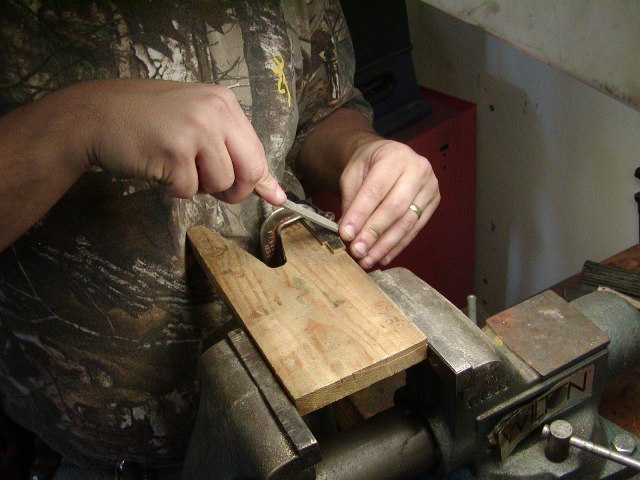
I decided to let Josh outline the mortice for the side plate because the thick brass gave him a nice edge to feel. So Josh screwed the plate in place and used a razor sharp knife with a pointed tip to trace the plate.
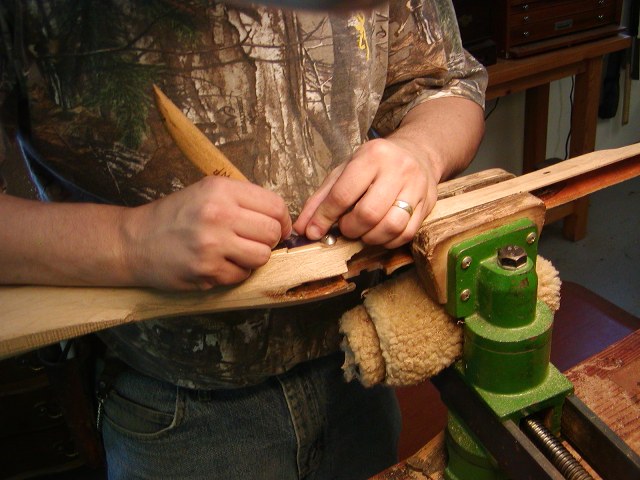
He did OK but he tended to put too much pressure on the knife such that it cut deep and caught wood grain that led the tip astray. He did not grasp my direction to use a light touch because all he was doing was scribing the outline. We deepened it by stabbing in after marking it. Anyway, the stock will have a few scratches around the plate after finish but they won't show very much. I corrected and cut the outline and back cut to create an edge to the mortice that Josh could feel. He removed the background.

The inlet came out great. There are a few tiny gaps but they will disappear when the wood is stained and finished. I want to emphasize how difficult this is. When using a chisel, he has to have his hand on the tool but low enough near the blade so he can use his pinky to feel where it is going. Then he has to tap the chisel with his other hand. He tends to position the chisel at the right angle but when he gets ready to tap it, he unconsciously lowers the angle of the chisel so it skips over the wood. He has to consciously raise the end of the tool before every tap. Acer had an idea that Josh may do better if, rather than a mallet, he hits the chisel with a flat weight in his hand. It may give him one less thing to think about.
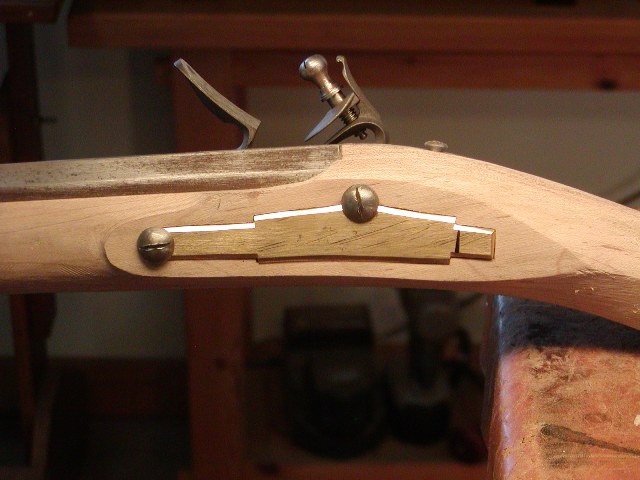
The rest of the day was shaping the stock further. Josh did well but as we get closer to the finished product it is clear that I have to do more of the work. There are subtle details that he cannot perceive but we will try to push his capabilities as far as we can. Here is where we are and you can see minor gaps in the inletting and some imprecision in shaping, but most of that will disappear in the final form and Josh has done a remarkable job.

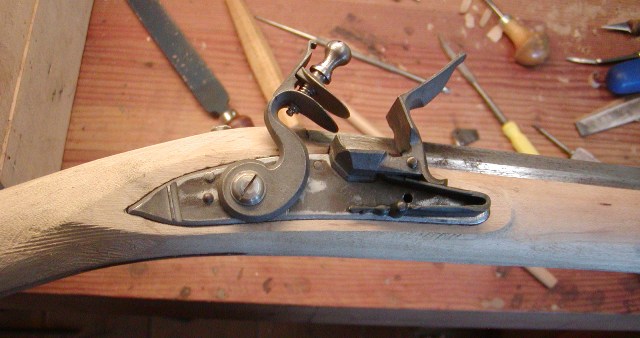

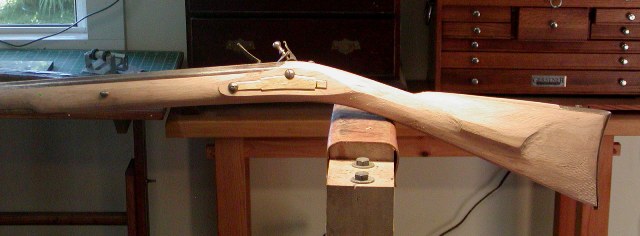
I communicate all your responses to Josh and he appreciates the support a great deal. Thank you all for looking and commenting.
dave
We got more done last Saturday. It was time to make and install a side plate. I modeled one from a 1770s vintage Lancaster gun and used an old cast English plate as the raw material. I cut out and filed the outline and then had Josh clean up the edges and file the bevel. He did a great job with the task.

I decided to let Josh outline the mortice for the side plate because the thick brass gave him a nice edge to feel. So Josh screwed the plate in place and used a razor sharp knife with a pointed tip to trace the plate.

He did OK but he tended to put too much pressure on the knife such that it cut deep and caught wood grain that led the tip astray. He did not grasp my direction to use a light touch because all he was doing was scribing the outline. We deepened it by stabbing in after marking it. Anyway, the stock will have a few scratches around the plate after finish but they won't show very much. I corrected and cut the outline and back cut to create an edge to the mortice that Josh could feel. He removed the background.

The inlet came out great. There are a few tiny gaps but they will disappear when the wood is stained and finished. I want to emphasize how difficult this is. When using a chisel, he has to have his hand on the tool but low enough near the blade so he can use his pinky to feel where it is going. Then he has to tap the chisel with his other hand. He tends to position the chisel at the right angle but when he gets ready to tap it, he unconsciously lowers the angle of the chisel so it skips over the wood. He has to consciously raise the end of the tool before every tap. Acer had an idea that Josh may do better if, rather than a mallet, he hits the chisel with a flat weight in his hand. It may give him one less thing to think about.

The rest of the day was shaping the stock further. Josh did well but as we get closer to the finished product it is clear that I have to do more of the work. There are subtle details that he cannot perceive but we will try to push his capabilities as far as we can. Here is where we are and you can see minor gaps in the inletting and some imprecision in shaping, but most of that will disappear in the final form and Josh has done a remarkable job.




I communicate all your responses to Josh and he appreciates the support a great deal. Thank you all for looking and commenting.
dave
Great job. Wouldn’t worry one bit about any scratches. Adds to the gun’s character. Would consider them Josh’s signature. Every gunmaker leaves tell tale signs that makes their work unique. Something to be proud of.
appalichian hunter
75 Cal.
- Joined
- Oct 28, 2018
- Messages
- 5,828
- Reaction score
- 9,477
We are only limited bye our mind, there are no handicaps when one sets his mind to a project, Josh is proving this let no one tell you that you cannot do something, ask for help and help will guide you. Mr. Pearson you are a special person and Josh is outstanding in his quest. We all should take lessons from this project. Good building young man.
Similar threads
- Replies
- 35
- Views
- 4K
- Replies
- 27
- Views
- 1K
- Replies
- 8
- Views
- 523
- Replies
- 14
- Views
- 473



